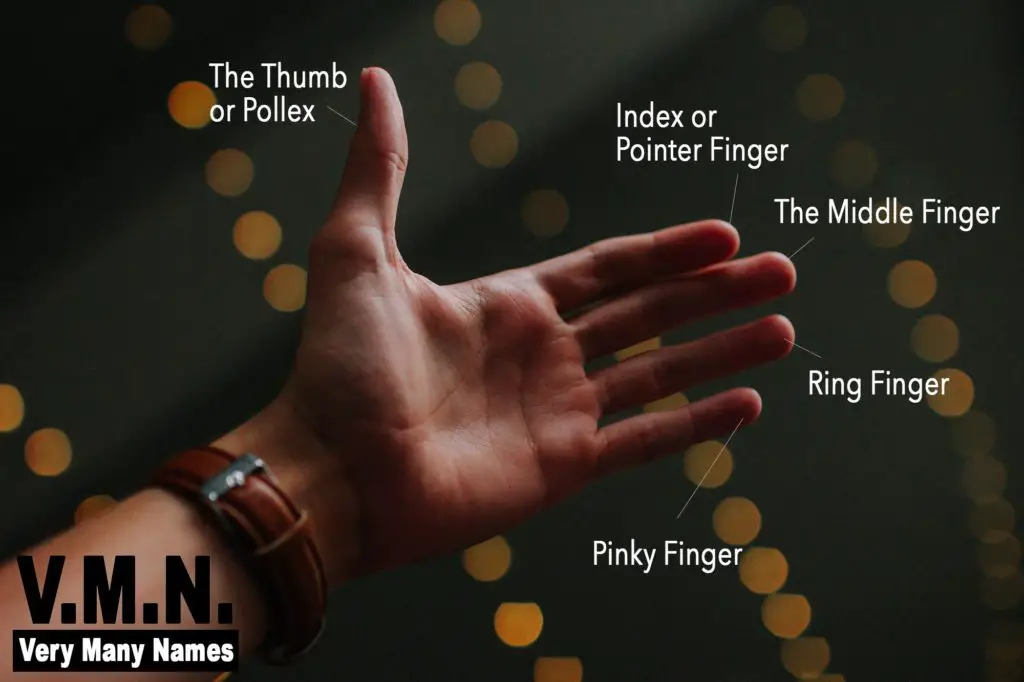Everybody knows what a thumb is, but what about all the fingers on a hand? Is the tiny finger on the end really called a pinky? And what about the other fingers?
The fingers’ names include the standard terms, such as index finger, middle finger, ring finger, and pinkie, to scientific names such as digitus manus secundus. Humans have also shown their creativity through names such as pot licker, Corazón, and weak man.
One version of the traditional nursery rhyme “Tommy Thumb” calls the fingers Tommy Thumb, Peter Pointer, Toby Tall, Ruby Ring, and Baby Small. Those are cute names, but we all know that the longest finger is not Toby—even when we’re playing with a toddler. Let’s explore their names to learn not only their common and scientific names but nicknames and the history behind the names.
Keep reading to learn more about the Names of the Fingers.

The Thumb or Pollex
Is the thumb even a finger? That depends on who you ask. In many languages, it is considered as separate from the fingers, a non-finger. It looks different, is not attached to the palm like the other fingers, and has a different range of motion. So do we have ten fingers or eight?
In several languages, notably Russian and Icelandic, the thumb is called “the big finger.” Maybe we don’t consider it a finger because of its location and size. However, in a 2005 study, researchers concluded the nervous system interacts with the thumb as though it is the fifth finger. They concluded it is best to think of it as a specialized finger.
That specialization is often referred to as prehensile—the ability to grasp something. Most mammals have prehensile appendages such as tails and hands (elephants have a prehensile nose or trunk). Our opposable thumbs can rotate so that we can make two grips–power and precision.
The medical term for thumb is pollex, a Latin word that means “to be strong.” Medical texts also describe it as “the first digit on the radial side of the hand.” The forearm has two bones, and the thumb is on the same side as the radial bone.
Index or Pointer Finger—the Finger Next to the Thumb
The finger next to the thumb is commonly called the index, pointer finger, or forefinger. In medical dictionaries, it is often referred to as the second finger (the thumb being the first). The Latin name is digitus manus secundus (second digit of the hand) or simply digitus II.
Because this name is commonly used to point or show, the pointer finger is an obvious choice. The index’s root is indico or indicare, meaning “to show.” The index finger was first used in the 18th century. Fore- means front or first, as in foreleg. Those who thought that the index finger was the first true finger called it a forefinger.
Other names for this finger include:
- Because it was used to pull a bowstring, it was called a shooting finger.
- Since it is used to pull a trigger on a gun, it can be called a trigger finger.
- If it is used to swipe out food from a pot, some call it a pot licker.
The Middle Finger
For most people, this is the longest finger. In some nursery rhymes, it is “Tall Man.” It is the middle finger because of its location. The medical term is digitus manus medius or digitus III. The Latin words for this finger show that it has been used to make an obscene gesture for the millennium:
- Digitus infamis–“the disgraceful finger.”
- Digitus impudicus–“the shameless, lewd finger.”
Some Turkish language dub it the “middle poplar,” in Spanish it is the Corazón, or “heart,” and in Portuguese Pai-de-Todos, or “Dad of all.”
Ring Finger
The digitus manus quartus, or digitus IV, is commonly known as the ring finger. Centuries ago, it was called the nameless finger in Europe. Some speculate that people in the Middle Ages decided it should not be named because it had mystical healing uses.
But other cultures also label it as a nameless finger. In some ways, it is an unremarkable finger, neither obscene nor tiny. The history of its name is anything but unremarkable.
In modern times, the fourth finger is where engagement and wedding rings are worn. That was not always the case, though. In the 15th and 16th centuries, rings were often placed on the thumb. In an orthodox Jewish wedding, the groom places the ring on the bride’s right index finger.
Over time, wedding rings came to be worn on the fourth finger, most likely due to a mixture of religious and symbolic reasons. In medieval times, people believed a nerve or artery connected the ring finger to the heart.
The ring finger came to be used by doctors to stir and apply ointments. This superstition was most likely based on the uses for the other fingers—the index finger pointed out wrongdoings, the middle finger was obscene, and the pinky was used to clean out earwax. For this reason, the fourth finger has the Latin name digitus medicinalis.
Children used to call this finger “weakman.” When the fingers are flexed, the ring finger cannot be extended. Of all our fingers, it is the weakest one. Maybe using it as the ring finger gives it a purpose.
Pinky Finger
In Latin, the pinky was termed the auricularis, “the ear finger.” This refers to everyday use—removing ear wax, although auricularis now refers to the muscles that attach the ear’s cartilage to the skull.
This finger’s medical term is digitus manus minimus or digitus V. But why call it a pinky, sometimes spelled pinkie, when it isn’t pink? Because the Dutch word for “little finger” is pink, and somehow it made its way to Scotland at the beginning of the 19th century.
Around the world, people have other nicknames for the little finger. They include:
- baby finger
- sparrow finger
- orphan
- last-born daughter
If someone tells you the pinky has no use, then make them “pinkie swear” to it. Most American children have made pinky promises. Koreans do the same, except they also tap their thumbs. The idea that red strings are tied around the pinkies is an Eastern symbol that a couple is destined to be together forever.
And how could we forget hinky-pinkies? Although not related to pinkies, they are still fun—two two-syllable words that answer a riddle:
- Q: How do you say goodbye to an alligator?
- A: Later, Gator.
Don’t let anyone tell you that the pinky has no use. And do not double-cross a Japanese gangster, or you will have your pinky chopped off.

What Is in Our Fingers?
Most of us don’t give too much thought to our fingers or hand until we hurt one and cannot use it. Our hands contain 27 bones and joints, 34 muscles, and around 100 ligaments and tendons, in addition to a vast network of blood vessels and nerves.
The bones in our fingers are called phalanges. Each finger contains three phalanges, with the exception of the thumb that has two.
The joints between the phalanges are called interphalangeal joints. Each joint has a name—the one below the fingernails is the proximal interphalangeal (PIP), and the one middle joint is the distal interphalangeal joint (DIP).
Finally, the joint connecting the finger to the palm is the metacarpophalangeal joint (MCP), but the knuckle joint will do.
Bottom Line
Humans have been resourceful in the naming of the fingers. Whether you want to stick with a simple numbering system, call them by their common names, or use nicknames, doing a deep dive on their names reveals our creativity.


